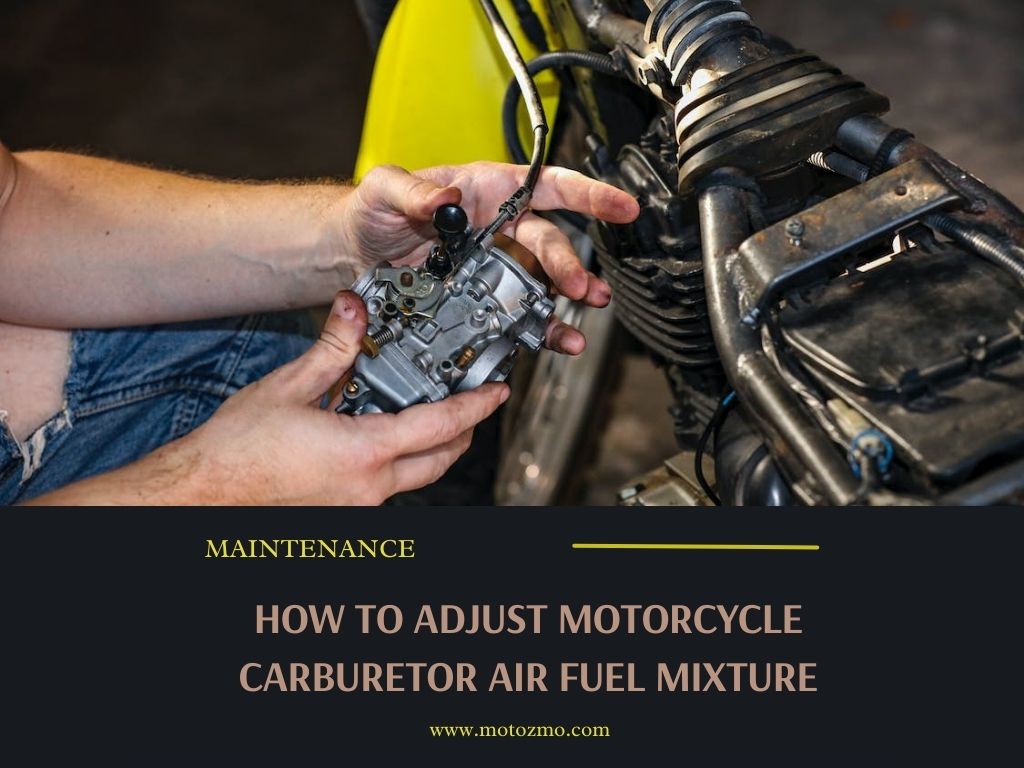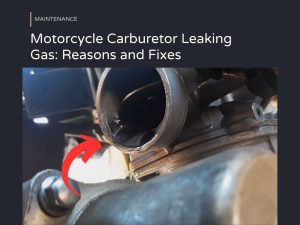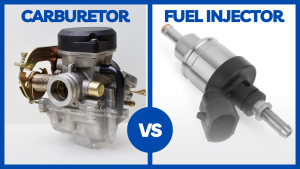Is your motorcycle engine sputtering, choking, or losing power? The problem could lie in the carburetor’s air-fuel mixture adjustment. It mixes air and fuel for your engine, and if the ratio is off, your bike won’t run smoothly. Adjusting the carb’s mixture is one of the simpler tasks a home mechanic can do, but it’s important to get it right.
Follow along as I walk through how to assess your air-fuel mixture and adjust the carb jets and valves to dial in the perfect ratio for your riding needs. With a bit of time and patience—and some trial and error—you’ll have your trusty steed purring again in no time.
How to Tell If the Air Fuel Mixture Is Off?
Cruising the open road on two wheels is pure bliss…until your trusty steed starts sputtering and choking. You tear open the garage and whip out your tools, ready for a carb tune-up. See, your motorcycle’s carburetor controls the air-fuel mixture that makes its engine purr (or roar). If that mixture’s off, you’ll be pushing your ride home.
But how do you tell if the mixture is off?
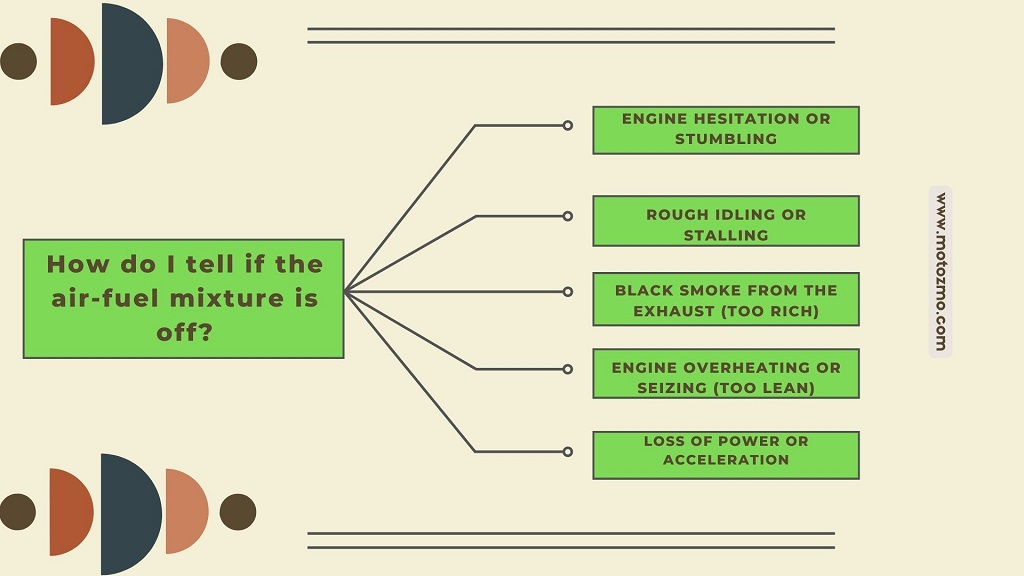
- Engine hesitation or stumbling
- Rough idling or stalling
- Black smoke from the exhaust (too rich)
- Engine overheating or seizing (too lean)
- Loss of power or acceleration
If you notice any of these issues, it’s a good idea to adjust your carburetor’s mixture.
Why Is Adjusting the Carb’s Air Fuel Mixture Necessary?
Sure, carbs seem simple—just a few valves and jets. But dialing them in right is an art and science. You’ll need to sync the carbs so both cylinders get the perfect ratio throughout the rev range. Too rich a mixture and she’ll bog down; too lean and she’ll seize up faster than you can say “premium unleaded.”
Today’s hogs have an edge with electronic fuel injection, delivering consistency carburetors can only dream of. But for those of us riding vintage V-Twins or dirt bikes, knowing how to tune our carbs to perfection is mandatory.
It’s part of the romance—and frustration—of riding old-school. Once you get in the zone adjusting those jets, though, the reward of a smooth-running engine makes the tinkering worthwhile. You’ll be burning rubber in no time, all thanks to getting intimate with your carb.
You May Like: How Does a Motorcycle Carburetor Work?
How to Adjust the Air-Fuel Mixture in a Motorcycle Carburetor
It’s time to show that carb who’s boss. Your trusty steed’s been sputtering again, and you know what that means—the air-fuel mixture is off.
No worries, adjusting the carb’s mixture screw is easier than impressing a date with your DIY skills. So, roll up your sleeves, grab a brew, and let’s get intimate with your carb.
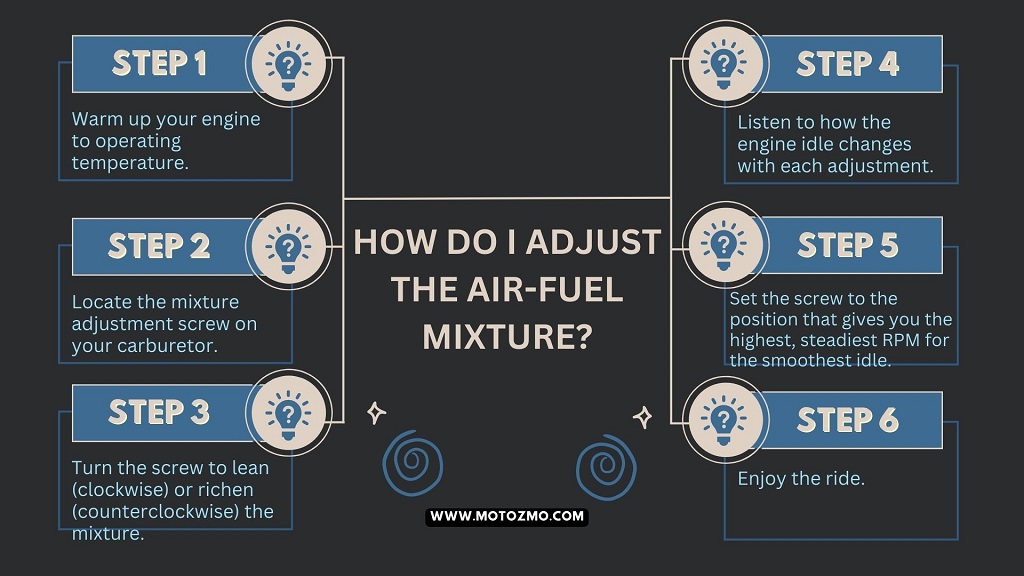
Prepare the engine
Before adjusting your carburetor, it’s important to get a sense of how your engine’s currently running. So find a safe, open spot and start up your bike for a few minutes until the engine’s warmed up.
As it idles, listen closely to the engine’s sounds. A properly tuned engine should idle steadily with a consistent tone. If it’s sputtering or stumbling, the mixture’s likely too lean. If it’s roaring loudly, the mixture’s probably too rich.
Once you’ve got an ear for your engine’s “happy place,” try revving the engine in a lower gear while stopped. Again, listen for any roughness or lack of power—this can reveal lean or rich spots in the mid-range that idle speed alone might miss.
Taking the time to learn your engine’s tones will help you diagnose and dial in the perfect mixture. But avoid high-rpm tests in residential areas, or your neighbors might dial 911!
Find the air-fuel mixture screw
After warming up your ride to get the carburetor party started, it’s time to hunt down that elusive air-fuel mixture screw. This flashy little fellow—usually brass and gold as a medal of honor for your tuning skills—is dying for you to turn him and get the mixture just right.
Look at the side of the carb. Check every screw for a flat head and slot, like a hipster’s glasses. When you spot Mr. Right, turn him in for richer fuel or more air depending on what your engine’s craving.
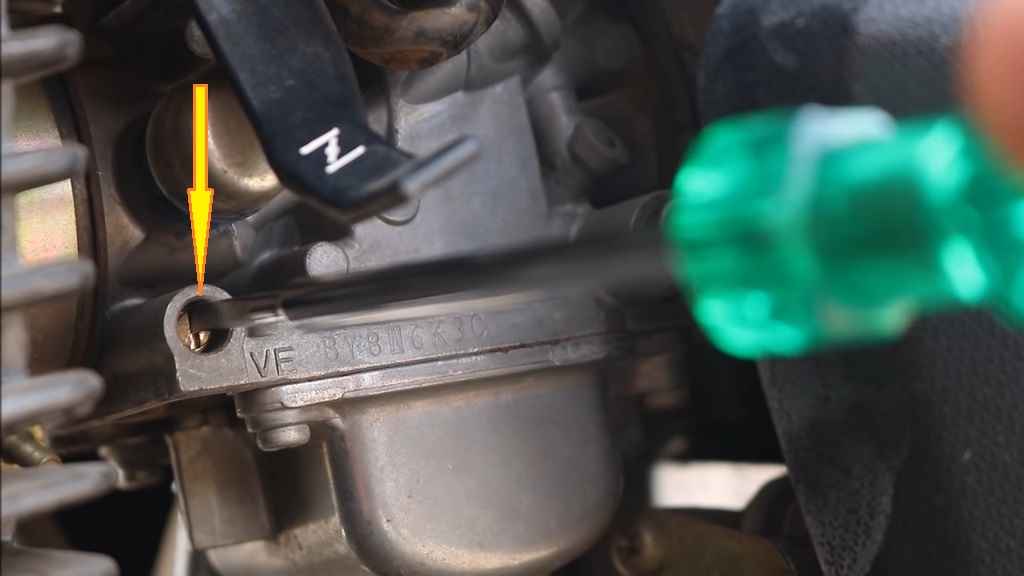
Turn the screw clockwise
Grab your trusty flathead and start turning clockwise. It’ll weaken the mixture and cut fuel flow. So, listen for your engine’s idle to shift from a purr to rough coughs. Once your ride’s hacking like a 40-year smoker, you’ve gone far enough.
Leaning out your mixture this way lowers idle RPM and saves gas but take it too far and you’ll be visiting your mechanic to treat friction and overheating.
So go easy. You’re here to fine-tune, not push your engine to the brink. A little rough idle never hurt, but if the whole bike’s shaking you’ve taken this mixture meddling too far.
Loosen the screw
Grab that screwdriver again and spin counterclockwise, pouring on the fuel with every turn. As the mixture gets richer, your engine will start racing—once the idle is irregular, you’ve given her enough juice.
A richer mixture means higher idle RPM and more power but lay it on too thick and you’ll be trading fuel economy for clouds of smoke. We’re here for precision, not smoke shows.
So, turn that screw easy and keep counting. If you’ve gone more than a handful of turns, it’s time to start over. Your engine will thank you for taking it slow.
You May Like: How to Clean a Motorcycle Carburetor Without Removing
Set the screw in a middle spot
Last step—finding screw Nirvana. You’ve gone lean enough to make your engine hack and rich enough to send it racing, so now tease out that sweet spot in between.
Turn the screw clockwise until your ride’s idling steady as she goes, not too rough and not too fast. When the screw’s back to middle ground, you can call it: mixture’s dialed.
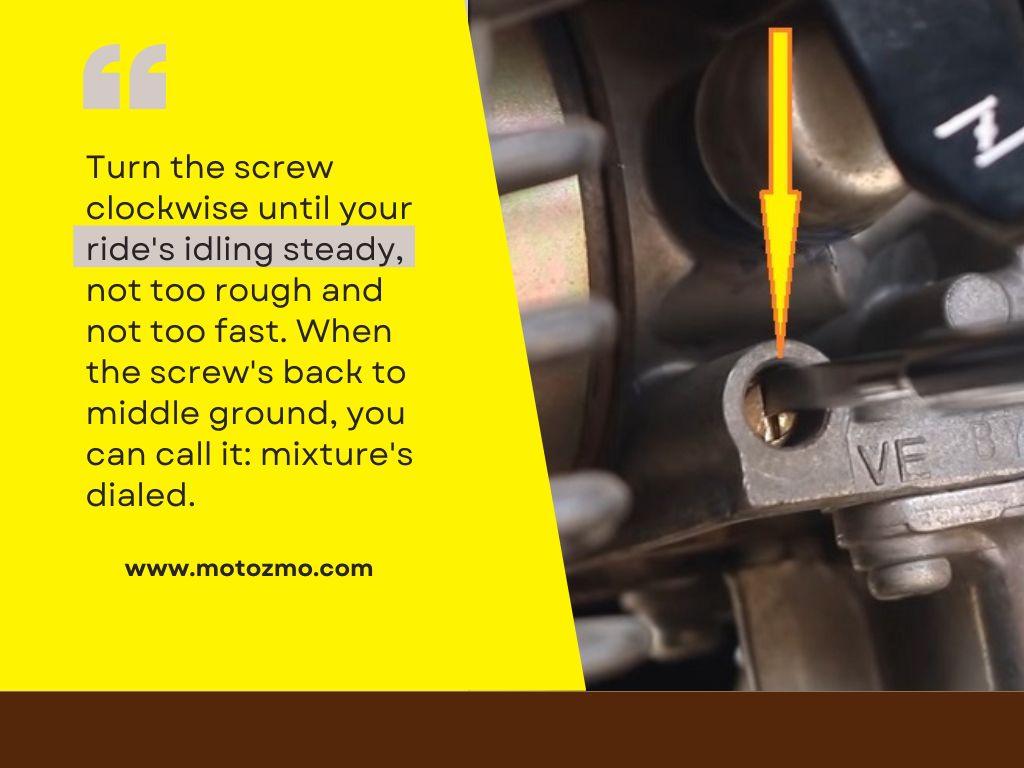
After all that temptation, your carb’s mixture screw has earned a break in mediocrity. But don’t worry, you’ll be getting intimate again once your engine needs another dose of your tuning magic.
Make adjustments 1/2 a turn in either direction
It’s time to find the perfect idle speed.
Turn that mixture screw half a turn left and right of center and lend your engine a listening ear. Somewhere between should be that perfect idle. Can’t find the sweet spot? No worries, middle ground won’t let you down.
You’ve got your engine’s AFR balanced, the sacred 14.7:1. Treat your ride right and she’ll treat you right—but get too precise with the tuning and you’ll be busting out the AFR meter like a pro. For your daily driver, close enough is good enough.
Turn that mixture screw half a turn left and right of center and lend your engine a listening ear. Somewhere between should be that perfect idle, steady as an old faithful dog. Can’t find the sweet spot? No worries, middle ground won’t let you down.
Now go open her up and listen to that balanced idle purr!
Looking for a video tutorial? Watch this:
Adjusting the Air-Fuel Mixture: Some Tips
Adjust the mixture with the engine warmed up and running. Cold engines need a richer mixture, so adjusting with the engine warm ensures you’re setting it properly for normal operating conditions.
Adjust the mixture one carburetor at a time for engines with multiple carburetors. This ensures even mixture across cylinders and makes it easier to detect how each adjustment affects performance.
Make note of how many turns you adjust the mixture screw for reference. This can help you fine-tune the mixture later or return to a known-good setting if you over-adjust.
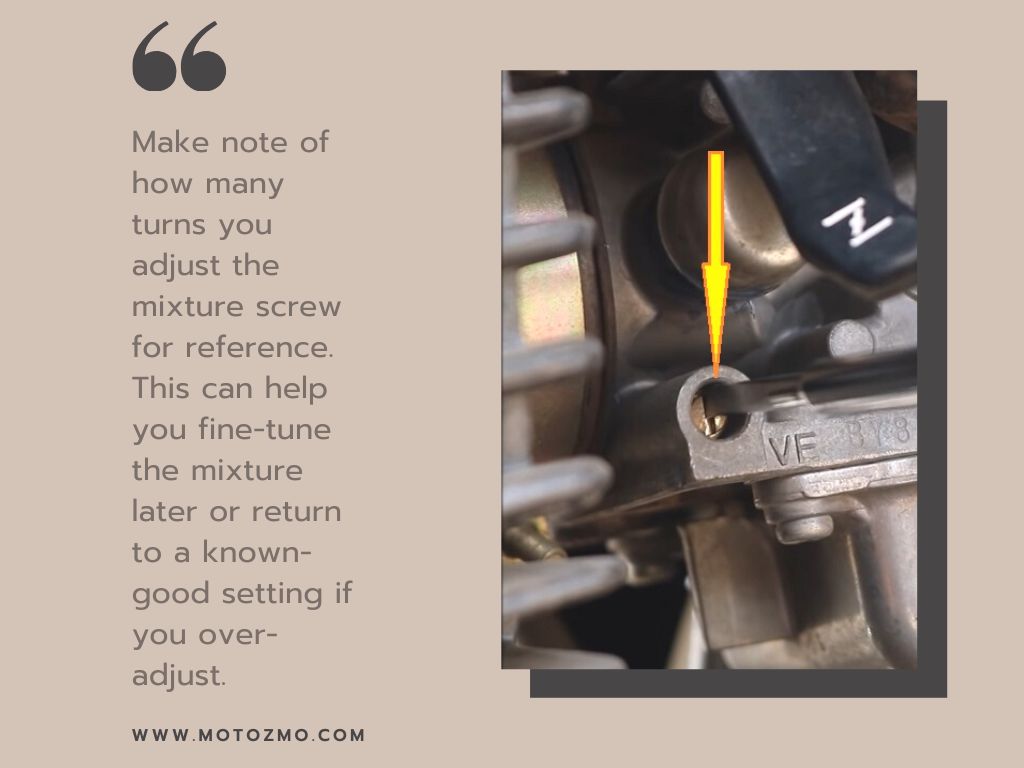
Test the new mixture under different riding conditions. A mixture that’s optimal for idle may be too rich or too lean under acceleration or load. Some trial and error while riding is often needed to get the mixture right for all conditions.
Consider using a combustion gas analyzer or wideband oxygen sensor to measure the actual air-fuel ratio if you’re having trouble getting it right by ear or if precision tuning is a must. These tools can show you the exact AFR, so you know you have the mixture spot on.
Be very careful not to over-lean the mixture, as this can cause engine damage. It’s best to err on the slightly rich side if unsure. An over-rich mixture may reduce performance and fuel economy, but it likely won’t harm the engine in the short term.
You May Like: Say Goodbye to Carburetor Gunk with Carb Cleaners for Motorcycles
Conclusion
Adjusting your motorcycle’s carburetor air-fuel mixture is one of the simpler maintenance tasks you can perform, but it’s important to get right for engine performance, fuel efficiency, and longevity. By following the proper steps to assess your current mixture and adjust the carburetor screws in small increments, you can dial in just the right ratio of air and fuel for your riding needs. While it may take some trial and error, with a little patience and know-how you can tune your carb and keep your bike running smoothly for the long ride ahead.
FAQs about Adjusting Motorcycle Carburetor Air-Fuel Mixture
Why is adjusting the air-fuel mixture important?
The air-fuel mixture controls how your engine runs. If it’s too rich (too much fuel), your engine may run sluggish, stall, or foul spark plugs. If it’s too lean (not enough fuel), your engine may overheat or hesitate under load. Adjusting the mixture helps your engine run efficiently and delivers optimal performance and fuel economy.
How much should I adjust the mixture screw?
Only make small adjustments to the mixture screw, about 1/4 turn at a time. Significant or rapid changes to the mixture can negatively affect performance or damage the engine. After each 1/4 turn, start the engine and listen to how the idle changes to determine if you need to adjust further or revert to the previous setting. It’s a good idea to adjust the mixture a little at a time until you reach the optimal setting for your engine.
What tools do I need to adjust the air fuel mixture?
The only tool you typically need is a flathead screwdriver to adjust the mixture screw. Some carburetors may use a Phillips head screw instead, in which case you’ll need a Phillips head screwdriver. It’s a good idea to have a socket wrench as a backup in case the screwdriver isn’t enough to break the mixture screw loose.
What if adjusting the mixture doesn’t help?
If adjusting the mixture screw doesn’t seem to help or makes the issues worse, there could be other problems with your carburetor or engine:
1. The carburetor may be dirty or jets clogged, requiring cleaning or rebuilding.
2. The float needle valve could be sticking or the float level out of adjustment.
3. There could be vacuum leaks in the intake or issues with valves, compression, or ignition.
For significant or persistent problems, it’s best to have the carburetor and engine checked by a mechanic.
Do I need mechanical skills to adjust the mixture?
Adjusting the carburetor air-fuel mixture is a relatively straightforward task, but it does require some mechanical inclination and comfort working around the carburetor and engine. If you’re not mechanically inclined or don’t feel comfortable making the adjustment yourself, you can have a mechanic handle the task to ensure it’s done properly. For many bikes, it’s an inexpensive job for a shop to perform if you provide clear direction that you just want the mixture adjusted.

